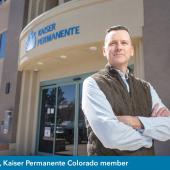Life 2.0
A few weeks ago, I returned to Colorado Springs Orthopaedic Group to interview Annie Lopez. Annie was lively and vivacious, and she told me the story of her last six years in twelve seconds. When we sat down, she placed a bright green thermos on the table between us. It was covered in polished stickers of national parks, marine life, and camper trailers. Then she cupped both hands together, raised them to my eyes, and said, “I used to take this many pills every day and still lived in pain.”
Six years ago, Annie took two wrong steps in the kitchen and was hit with such intense and sudden pain throughout her body that she thought she had been struck by lightning. Annie was experiencing the worst pain of her life. But because there was no obvious cause of injury, ER doctors hesitated to prescribe her pain medication. “For the first time in my life, I knew what it was like to say that my pain was at a ten. I told my husband I can no longer think; you are in charge of me now.” Her pain eventually grew so severe that she could only sit still and repeat the phrase, “Nobody dies from pain” over and over in her head. Finally, when she lost her ability to walk, a doctor recommended an MRI. They discovered that a disc in her back had shattered and ricocheted throughout her body like shrapnel.

One of the nerves in Annie’s back was permanently damaged from the incident, and so even after the remnants of the shattered disc were removed, she was still living in intense chronic pain. “I wasn’t in pain as long as I didn’t move. But how long can you do that? Breathing is moving.” She would spend days at a time sitting as still as possible on her couch. Before the accident, Annie, a Colorado native, lived an active life. She gardened, skied, hiked, and went on countless scuba trips. But now she wasn’t training to climb fourteeners; she was meeting with pain management doctors and physical therapists just to be able to survive a trip to the grocery store.
I have lived in Colorado for a little over a year, and about once every two weeks since I moved here, I have heard some variant of “You’re more likely to get injured on your drive to go _____ than you are actually ____ing. You can fill in the blank: climbing, skiing, hiking, etc. It’s a cliche, but it’s a cliché for a reason. It gets a good point across. The mundane parts of our lives are more dangerous than we are comfortable acknowledging. A car wreck, a fall down the stairs, or any number of tragedies could happen on a typical Tuesday afternoon, yet none of us are penciling these events into our weekly planners. I type this on a Sunday with no idea how many eyes or toes I will have when I wake up next Sunday.
Annie wasn’t planning on shattering a disc in her back. But with two steps across her kitchen floor, her life was taken from her. She was living in such crippling pain that she couldn’t be a present friend, wife, or grandmother. Physically and emotionally, she was torn down, just hardly surviving. For four years, “I was just hauling a body around.” Reflecting on that period, Annie can now see how close she was to complete despair. “When all of the pillars of your life get taken out, when there is no joy, what’s the point?” And so, based on a friend’s recommendation, she got a second opinion from Dr. Sung with Colorado Springs Orthopaedic Group. Dr. Sung told her he could do nothing for her surgically, but she would be a perfect candidate for a Spinal Cord Stimulator. This small implanted device sends low levels of electricity directly into the spinal cord to stop pain signals from reaching the brain.
Annie didn’t hesitate, “When somebody tells you they’re going to implant a small computer in your hip and jam wires up next to your spinal cord, and you say “I’m so excited, sign me up!” that’s a good indication of how bad things are. If someone had told me to eat a box of sheet rock screws, I would have done it.”
A few days later, Annie was put on a less invasive trial device, and the results were swift and life-changing. “On the third day of the trial, I was standing on the back patio looking at my backyard, and I started crying. I forgot what it felt like not to hurt.”
A few months later, Annie got a permanent Spinal Cord Stimulator implanted in her back. Getting one of the devices implanted isn’t an easy or painless process, but even after just six weeks, Annie’s quality of life had dramatically increased. She was back to doing the things that she loved; she was playing in the dirt in her garden, hiking, and scuba diving again. She could go to festivals with her friends, she could play with her granddaughter. She is on less than a third of the pain pills she used to take and is going on adventures beyond the grocery store. This past summer, she hiked the “Mighty Five” national parks in Utah: Arches, Bryce Canyon, Canyonlands, Capitol Reef, and Zion. It’s all a little different now. She uses hiking poles, takes more breaks in the garden, and she keeps a plush mattress in her camper trailer. But she’s back. The model of Stimulator Annie chose even allows her to scuba dive again.

Annie told me that she doesn’t like to go that deep when she scuba-dives. She rolls off the boat carrying a magnifying glass and sits just a few feet under the water. She spends her oxygen looking at all of the little details hidden within the coral beds, enjoying the secret beauties that only those who take the time to look for will find. That seems to be the way that she has been approaching life since hers was returned to her. Reflecting on her incident, Annie said, “You realize just how delicate you are, how quickly everything can change.” Annie was incredibly fortunate for her body to have responded so well to the Spinal Cord Stimulator, and there is no guarantee that it will always work. As we spoke, she took several chances to remind me that it could all be taken away from any of us at any moment. A car wreck, a diagnosis, it’s all unknown. Life is fragile and unpredictable, but that doesn’t mean we should live in fear. The more compelling option is gratitude. It’s in recognizing our fragility that we can see the beauty and wonder in front of us more clearly, even if sometimes we have to use a magnifying glass.
Annie told me that sometimes she is afraid. What if the pain gets worse? What if the Spinal Cord Stimulator stops working? But these concerns are outside her control. “All you can do is count your blessings and keep going.” And so, in the meantime, her plan is to just keep playing in the dirt.
What I find most interesting about Annie’s story is just how quickly her life was both ruined and recovered. A few steps in her kitchen shattered a disc in her back, and a few weeks of recovery after surgery and everything was returned to her. We all live in a world full of surprises. And one of the challenges that comes with that is being able to live in the thankfulness of what can be taken away--and the hope of what can be restored.





